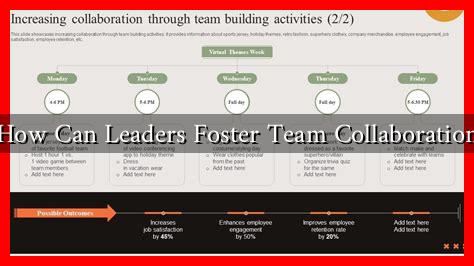-
Table of Contents
How Can Leaders Foster Team Collaboration?
In today’s fast-paced and interconnected work environment, effective team collaboration is more crucial than ever. Leaders play a pivotal role in fostering an atmosphere that encourages teamwork, creativity, and productivity. This article explores various strategies that leaders can implement to enhance collaboration within their teams.
The Importance of Team Collaboration
Team collaboration is not just a buzzword; it is a fundamental aspect of organizational success. According to a study by the Institute for Corporate Productivity, organizations that promote collaboration are five times more likely to be high-performing. Effective collaboration leads to:
- Increased innovation and creativity
- Improved problem-solving capabilities
- Higher employee satisfaction and retention
- Enhanced productivity and efficiency
Given these benefits, leaders must actively seek ways to cultivate a collaborative environment.
Strategies for Fostering Team Collaboration
1. Establish Clear Goals and Roles
One of the first steps in fostering collaboration is to ensure that team members understand their roles and the overall objectives of the team. When everyone knows what is expected of them, it reduces confusion and aligns efforts towards common goals.
- Define specific, measurable, achievable, relevant, and time-bound (SMART) goals.
- Clarify individual responsibilities to avoid overlap and ensure accountability.
For example, Google uses OKRs (Objectives and Key Results) to set clear goals that align teams and individuals, fostering a sense of purpose and direction.
2. Encourage Open Communication
Effective communication is the backbone of collaboration. Leaders should create an environment where team members feel comfortable sharing ideas, feedback, and concerns. This can be achieved through:
- Regular team meetings to discuss progress and challenges.
- Utilizing collaboration tools like Slack or Microsoft Teams for real-time communication.
- Encouraging an open-door policy where team members can approach leaders with their thoughts.
A study by Salesforce found that 86% of employees and executives cite lack of collaboration or ineffective communication as the primary cause of workplace failures.
3. Foster Trust and Respect
Trust is essential for effective collaboration. Leaders can build trust by:
- Being transparent about decisions and changes within the organization.
- Encouraging team members to share their ideas without fear of criticism.
- Recognizing and celebrating individual and team achievements.
For instance, the company Zappos is known for its strong emphasis on company culture, which fosters trust and respect among employees, leading to high levels of collaboration.
4. Promote Diversity and Inclusion
Diverse teams bring a variety of perspectives, which can enhance creativity and problem-solving. Leaders should actively promote diversity and inclusion by:
- Recruiting from a diverse talent pool.
- Creating an inclusive environment where all voices are heard.
- Providing training on unconscious bias and cultural competence.
Research from McKinsey shows that companies with more diverse teams are 35% more likely to outperform their peers in terms of financial returns.
5. Leverage Technology
In the digital age, technology plays a crucial role in facilitating collaboration. Leaders should leverage tools that enhance teamwork, such as:
- Project management software like Asana or Trello to track progress.
- Video conferencing tools like Zoom for remote collaboration.
- Cloud storage solutions like Google Drive for easy access to shared documents.
According to a report by Gartner, 74% of organizations plan to shift to remote work permanently, making technology even more vital for collaboration.
Conclusion
Fostering team collaboration is a multifaceted endeavor that requires intentional effort from leaders. By establishing clear goals, encouraging open communication, building trust, promoting diversity, and leveraging technology, leaders can create an environment where collaboration thrives. As organizations continue to evolve, the ability to work effectively as a team will remain a key driver of success. Embracing these strategies not only enhances team performance but also contributes to a positive workplace culture that attracts and retains top talent.
For further insights on fostering collaboration, consider exploring resources from the Forbes Human Resources Council.

